Category: Neighborhoods
The Mysterious Ms. Pulva
June 23, 1907
Los Angeles
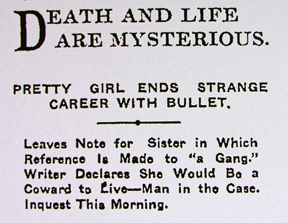 What can one say about pretty young Eva Pulva? She lived in a lonely cottage on West Fifty-Fourth, and though her mother and sister lived on East Fifty-Seventh, she told people she had no kin. Her gentleman friends knew little of her. The police knew her best of all—watching as she, a ward of the probation department, came to the verge of trouble via men of low character. But she’d secured her nice little cottage, and things seemed to be going well…
What can one say about pretty young Eva Pulva? She lived in a lonely cottage on West Fifty-Fourth, and though her mother and sister lived on East Fifty-Seventh, she told people she had no kin. Her gentleman friends knew little of her. The police knew her best of all—watching as she, a ward of the probation department, came to the verge of trouble via men of low character. But she’d secured her nice little cottage, and things seemed to be going well…
…until she shaved her head and disappeared. The cops looked for her to offer her protection from whatever trouble she was in, but didn’t find her until she had a self-inflicted bullet in her chest.
Her note read “Dearest Sister: You will find my trunk at 2739 Budlong avenue. Please don’t tell the lady you are a relative of mine. I told her I had no relation. So let me go knowing that one person on your Sunny Earth don’t think me a liar. I am sorry I don’t leave espense money but (I belong to a gang that have my money) and when they hear I am goine most likely you will get it. Don’t tell mother. I wrote anything. Put me anywhere sister. I do don’t care where. I know you understand and my dear I am no good here…I am a coward to live but not a coward to die.”
Sleeping Like A Baby
June 14, 1907
Sonoratown
Mrs. Santos Rodriguez (nee Galvies) has a lover, Virde Parra. She also has a little 3-year-old daughter, and watching the babe was putting a crimp in her romantic life. A quick trip down to the druggist provided mama with what was almost certainly a bottle of lauadanum, that effective blend of opium and alcohol so beloved by Coleridge and de Quincey. As the child slipped into a powerful sleep illuminated with extraordinary visions, Santos slipped out of her little house at 643 Buena Vista Street and met Virde for a quickie at the La Guerra Hotel on North Main Street near Market.
But the lovers’ plans were thwarted when the lady’s husband, having heard rumors of her evening wanders and Parra’s visits, came home for an early dinner and discovered his child insensible. Patrolmen Leon and Murphy were called, and the child-doper and her honey were quickly found and placed in police custody, where the lady gave her maiden name and refused to talk about the case.
Now That’s a Headline

June 13, 1907
Los Angeles
Voters approved a $23-million bond issue ($472,042,116.32 USD 2005) for the Owens River Aqueduct, 21,923-2,128. The Times helped mount a turnout campaign in which automobile owners volunteered to ferry voters to the polls.
Interestingly enough, The Times put the story on the first page of the second section rather than the front page.
Lmharnisch.com
Lmharnisch.blogspot.com
Further Dispatches from Divorce Court
May 30, 1907
Los Angeles

Call me an embittered divorcée—male though I may be—but it seems I can’t get enough of any tale involving marital disharmony (cf. May 25, or more saliently, May 17). Those in the thrall of wedded bliss, or, more likely, righteous pique, tut-tut our modern divorce rate. Well…
Old soldier Alonzo Stuart, 70, met Ida, 38, at a Sawtelle church. She spoke to him without an introduction (!) and during said discussion he revealed he owned an acre down on Fourth Street. They took a stroll to go look at the property, whereafter she promised to be a good and loving wife. He deeded her the acre. We know where this is going.
A good and loving wife she was not, as was evident on the very day of their marriage. While eating iced cream in Eastlake Park, the elder Stuart laid his arm affectionately across the shoulder of his new bride, but she moved her chair away, saying she did not care to be slobbered over. Stuart pal Frank Conckling recounts further tales of newlywedded smoochiness, including this one, after his visit to the Stuart’s Sawtelle home on Sixth: “She was sitting outside reading a murder story from a sensational paper. I asked her where Stuart was, and she said: ‘He’s inside cleaning up his dirt.’ I went in and found him down on his knees, scrubbing the floor.” Ida also reportedly stated to her husband that she was not going to be dictated to “by any damn man.”
At the trial, Alonzo admitted to being, at times, remorse and sullen, but only because his heart was grieving. And yes, he did brandish a pistol, but was calm and quiet and in fact perfectly good natured while doing so.
Ida recounted that they argued frequently—for example, she wished to go to the beach without him. “The last fuss we had was over religion,” she said. “There are so many different kinds of religion in Sawtelle.”
The value of the disputed property is $1,400.
Historic Cobblestones Exposed in Lincoln Heights
May 27, 2007
Los Angeles
It is more than two weeks now since the graders came and removed the surface layer of the asphalt on Avenue 20, between Albion and Broadway, then went away without finishing their work. For all that time, the NO PARKING signs have hung on the telephone poles, and the regular parade of shortcutting commuters have bounced along on their unhappy shocks, as the street beneath them grew more uneven and dilapidated.
After a week, a flash of red edged by corroded silver was visible on Avenue 20 just before Broadway. A careful peek between passing cars revealed a long-buried light rail track, with a row of handsome, narrow brick placed alongside it.
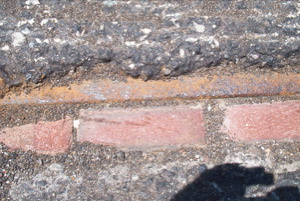
For this neglected area, just NE of downtown on the far side of the river, was once a thriving commercial and residential community, with trains running frequently down the middle of the streets.
Here is a map of the immediate vicinity, drawn in 1906. The yellow lines demark the Yellow Trains of the Los Angeles Railway Company, and just in the middle heading approximately north-south you’ll find the line that ran along Avenue 20, passing between Main Street and Downey, now known as Broadway. Behind the dead end at Main, the Los Angeles Brewing Company, now the Brewery Arts Complex. Avenues 21 and 22 are ghost streets, their rows of Victorian cottages bulldozed so the 5 can whisk folks away at speeds unimaginable in ’06. Mayden too is no more. And the red line along Daly is a Pacific Electric Railway Company train.
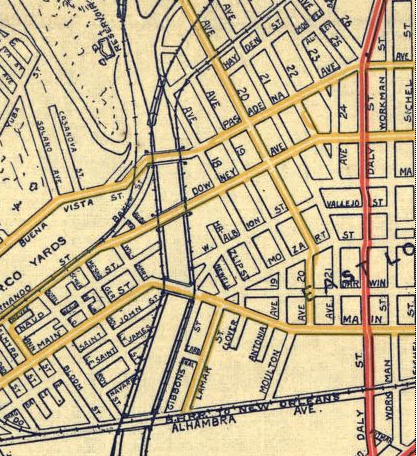
Back to the state of the very sad street. Well into the second week with the gravel laid bare to constant steamrolling by SUVs and minivans, new patches opened up closer to Albion Street. Viewed from behind the windshield, these had a strangely archaic quality that demanded further inquiry.
Here is the intersection, with the peculiar patch visible in situ. You can see how dangerous it is to get close to the quarry:
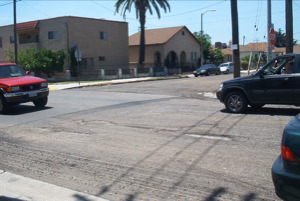
But your intrepid reporter would not be daunted in her quest to see if that was really what it appeared to be. Wait for it… wait and… wait and… dash out and take a snap!
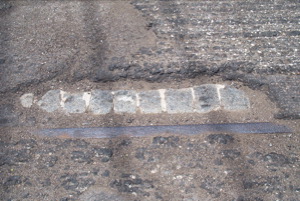
Aaaaahhh! Yes, those truly are cobblestones, that timeworn weapon of the disenfranchised European citizenry, laid alongside the old tracks in the heart of 21st Century Los Angeles. And somewhat haphazardly mortered, too. How extraordinary!

City of L.A., your street services suck, but I can’t really be angry that you scraped up my block and disappeared, because the sight of long-covered cobblestones have a peculiar calming effect on history geeks. So thanks a million for the cool experience. I’ll never look at the street the same way again. Now will you please get some guys over here to pave the freaking street?
your pal,
Kim
A Sad Day For the Officers
May 25, 1907
Los Angeles
For eleven years, pigeons have filled the nooks and roosts of the city’s police station, watching over the parade of troubled souls who come to that refuge, some dragged in bodily, others seeking aid. The police officers have coddled their feathered confederates, keeping them fat with daily offerings and giving names to the most distinctive of their numbers.
All that ends tomorrow, by order of the city’s judges and police officials. They have determined that the impromptu coop is a filthy nuisance and a hotbed of avian vice, and with that stark declaration, these spoiled creatures have been sentenced to death by sniper.
Yes, they will all be shot–starting with Old Bill, the big black male who reigns over his flock, and followed by all his courtiers, wives, children and cousins. Once their fate became clear, the officers insisted guns must be used, for they could not bear to snare and strangle their friends, and if they trapped and shipped them away, it would only be a matter of days before they returned to their longtime home.
Tonight the police station is a mournful place, and the sweet cooing of its aerial residents inspire only sadness in those below. Old Bill has but one night to live, and when he dies so too will a piece of the hearts of all who knew him.
Speed demons
Fleenor Talks
Los AngelesIn a jailhouse interview before he was taken to San Quentin, James G. Fleenor, the barefoot burglar, set the record straight on his escapes, his relationship with a white woman and how he began a life of crime.
It had been rumored that Fleenor returned to Los Angeles after escaping from a San Francisco jail because of his relationship with Mrs. B.J. Byres of 1669 Tennessee St. He insisted that he hopped the first freight train leaving the yard and discovered later that it was going to Los Angeles.
Fleenor, who used a real estate business as a front for his burglaries, said that she was one of only three customers who continued paying on her property after he was sent to jail.
Mad Mama?
May 13, 1907
Highland Park
15-year-old William McCormick visited the police to make a panicked plea for the salvation of his mother Janette, removed yesteday from 228 South Avenue 66 to the lunatics’ ward of the County Hospital. His mother is, William swears, quite sane, and her confinement the result of a family plot to steal her inheritance.
Mrs. McCormick is the primary beneficiary of a million dollar estate based in Denver, although much of the family lives on the west coast, including cousin Arthur Randall, in whose home the McCormicks had been staying.
Although no warrant for the woman’s arrest was ever produced, Superintendant Barber of the County Hospital accepted the word of the deputy sherrifs who brought the shrieking woman into his ward that such a warrant was in the hands of the Sheriff, and he refuses to release his captive until the case is investigated today.
Young McCormick explains, "After the death of my grandmother, mother and I came to the Coast. When our relatives learned that the greater portion of the property was left to mother and me, they began to plot. While we were in San Diego, Mrs. Belle M. Auston, who now lives in Black River Falls, Wis, and is my aunt, tried to kidnap me and was unsuccessful."
After this shock, the pair moved on to stay with a lady cousin in Ocean Park, then moved in with cousin Arthur. "He is the one who is making this trouble for mother. She is sane and has never been troubled with any symptoms of insanity. I believe that my uncles N.M. Phelps and A.D. Merrill of Denver have hired Randall to try to get mother in an asylum, so as to get her fortune! Phelps was left only $5000 by my grandmother’s will and Merrill was not mentioned. I am not very old, but I don’t want to see them harm mother."
The police sargeant told the youngster to contact the District Attorney.






